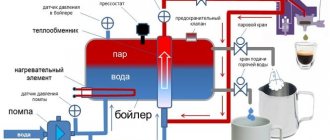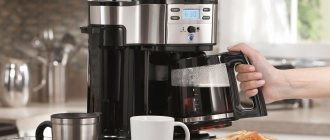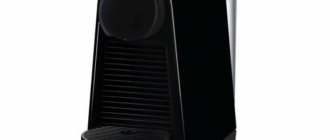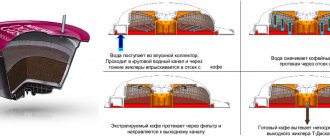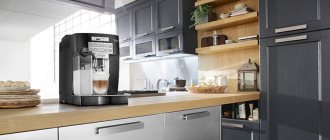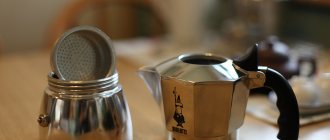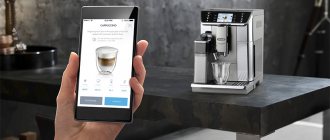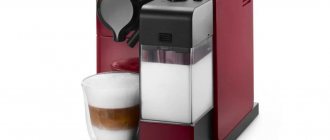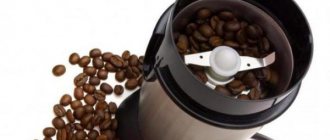Are you dreaming of a delicious cup of coffee that tastes just as good as the drink you get at your favorite café? Are you deciding which is better: a coffee maker or a coffee machine for your home? We will tell you what you need to know in order to make the right choice in this article, where we will look at various coffee makers and coffee machines, the principle of their operation, as well as the advantages and disadvantages.
Coffee maker or coffee machine for home: which is better to choose?
Before choosing a coffee maker or coffee machine for your home, it is worth understanding what is the difference between a coffee maker and a coffee machine, what is the difference in the coffee prepared by these devices, what is the operating principle of various coffee machines and coffee makers.
If you need one multifunctional appliance in the kitchen, then it is better to choose a coffee machine. You can choose the simplest horn model or an automatic one with advanced capabilities. Thanks to the huge assortment on the modern market, among the various models you can always find one that will take into account your individual needs. Below we will look at what to look for when choosing a coffee machine.
Do you know what one cup of coffee gives us?
As you can see, coffee not only has unique taste characteristics, but also has beneficial effects on health. You just need to cook it accordingly and consume it in moderation.
The first coffee machine was patented in 1884 by Italian Angelo Moriondo. At first it was a rather primitive device. It should be noted that pressure coffee makers were known even earlier, namely in the eighteenth century in France. These prototypes consisted of a jug with a lid. Today, there are amazing design solutions that allow you to prepare, in addition to coffee, chocolate, even using special capsules. What types of coffee makers and coffee machines are there and how do modern models differ?
Types of coffee machines and coffee makers
| Carob coffee machines (manual) | Automatic coffee machines | Capsule coffee machines | Geyser-type coffee makers |
Let's take a closer look at the different types of coffee machines and how a coffee maker differs from a coffee machine, what a geyser coffee maker is and why pressure is so important when preparing tasty and aromatic coffee.
Carob coffee machines
To make coffee in a coffee maker, otherwise known as a manual or mechanical coffee machine, you pour the ground coffee into a strainer (the coffee horn) and then attach it to the machine.
The drink is prepared under pressure. Depending on the depth of the filter, you can prepare one or two cups at a time. To prepare the next portion, you need to empty the cone and pour in the next portion of ground coffee. If you want your coffee with milk, you can also use the milk frother. Carob coffee makers differ in that, unlike automatic ones, they do not have a mill for grinding beans. So if you want to enjoy freshly ground coffee every day, you will have to purchase a separate grinder. For this type of coffee machine, it is better to use finely ground coffee.
Some models also allow you to use espresso bags.
It is better to choose a carob coffee maker if you:
- love the ritual of preparing this aromatic drink;
- Looking for an easy-to-use espresso device;
- I don’t mind cleaning the horn after each preparation.
Automatic coffee machines
The automatic model has an advantage over the carob model in that it includes a steel or ceramic mill in its design, thanks to which it can prepare a drink from grains or, depending on the model, also from ground grains in automatic mode.
This device has high pressure - at least 15 bar. If you like coffee with milk in addition to traditional black coffee, a coffee machine will be the best solution. These models allow you to prepare fluffy cappuccinos or lattes using the milk frothing attachment. Vending machines with advanced technological solutions independently select the appropriate parameters for preparing the drink: grain grinding thickness, amount of water and temperature for preparing the drink. This type of equipment uses finely ground coffee.
It is better to choose an automatic coffee machine if you:
- want to get a professional device that will prepare different types of coffee - espresso, cappuccino or latte;
- want to prepare a high-quality drink in a fully automated process;
- A lot of coffee is drunk in your home, and it is often prepared for the whole family and guests;
- quality is the most important and price is secondary.
Did you know? Are coffee grounds a great way to exfoliate at home? Just add a little olive oil or your favorite essential body oil, massage your skin and rinse, your skin will become softer. Regular use also helps fight cellulite.
Capsule type coffee machine
A capsule coffee machine does not take up much space on the kitchen counter, and its colorful appearance and the variety of coffees it can brew make it more and more popular among other models.
To prepare a tasty and aromatic drink, just insert the capsule and press the “Start” button, and after a while you can get a ready-to-drink drink prepared under pressure. This model means, first of all, convenience, since the used capsules go into a special container that is easy to clean. Some manufacturers offer collection of used capsules and their disposal.
It is better to choose a capsule coffee machine if you:
- Are you looking for a device that is easy to use;
- love aromatic coffee;
- prefer a minimum of work on cleaning the device;
- love quickly prepared coffee, chocolate or cocoa.
Geyser coffee makers
A geyser coffee maker is the simplest device that prepares coffee under pressure, although compared to the above options, it is relatively small.
But thanks to its small size, it can be used both at home and while traveling. To prepare the drink, you will need medium grind grains. The disadvantages of this coffee maker are:
- relatively long preparation time for the drink - about 8 minutes;
- every time you need to clean the sieve after preparing the drink;
- The drink will have no creamy foam.
Typically, geyser coffee makers can prepare a portion of a drink for 1-2 people, as they have a limited capacity, however, there are larger models. If you like coffee with milk, you need to froth the milk in a separate device designed for this.
A geyser coffee maker is for you if you:
- Are you looking for a device that is compact and easy to use;
- love aromatic coffee without grounds;
- want to save money.
Why we value carob coffee machines
This is a text for those who love good coffee, are planning to buy a carob coffee machine, but are not yet privy to the intricacies of coffee art.
Experts and professionals need not read further. But for novice coffee drinkers, the fundamental difference between carob and automatic coffee machines is often not obvious. Moreover, prices for high-quality carob coffee machines are often higher than for ultra-modern machines. Experts say that truly good espresso can only be prepared by a professional barista in a professional coffee machine. And it will be a carob (or holder) coffee machine.
The carob coffee machine got its name from the name of the part where the ground coffee is placed. This is a filter holder with a handle, which is called a horn, also known as a holder, or a portafilter.
The horn is one of the main design elements of a carob coffee maker. In order for the coffee to be tasty, the horn must be steel and massive - this is how it retains the temperature for a long time.
Espresso in a carob coffee maker is prepared as follows: freshly ground coffee is prepared in an amount of 6.5–7 grams in a coffee grinder with a grinding degree regulator. During the grinding process, the coffee immediately ends up in the filter bowl of the horn. Next, the coffee must be compacted with even force with a tamper to turn it into a coffee tablet called a pod. However, if the coffee is pressed too hard, the water will seep out more slowly than necessary, and the espresso will turn out bitter. And insufficiently pressed coffee will most likely be sour - the water will pass through too quickly. Next, you need to insert the horn and secure it tightly into the connector of the brewing group of the coffee machine and start the water supply.
For proper extraction, it is necessary that water at a temperature of 86–93 ° C and under a pressure of 9 bar passes through the coffee. The extraction time should be 20–30 seconds using 6.5–7 grams of ground coffee per 30–35 ml serving of finished espresso. Standards may vary depending on the type of coffee, degree of roasting, characteristics of the blend, taste preferences of the barista, etc. and so on. There are no less subtleties in preparing milk foam for cappuccino.
And why such complexity when there are automatic coffee machines? One click and the coffee is ready. Do you want espresso, do you want cappuccino! And no magic passes or kilograms of spoiled coffee!
Automatic coffee machines for home are chosen for their ease of use and modern design. Vending machines are good in any interior. But in most cases, coffee from a machine is inferior to a drink prepared by hand. It can be decent, good, very good, but not magical. Why?
The thing is that the taste of coffee is influenced by many factors: variety, fineness and uniformity of grinding, density of the coffee tablet, brewing temperature, extraction time, etc. and so on. Horn machines allow you to control all these parameters and experiment with them.
Achieving outstanding results with an automatic machine is difficult due to manufacturability and commonality. No matter how finely tuned the machine is, no matter how many parameters it monitors, it prepares the best of the average, but not the best of the possible. That's why you can't do without a person to make real espresso.
The Italians, who invented espresso and defined its standards, formulated the rule of four "M" of good espresso: Macchina espresso - coffee machine, Mescolanza - mixture of beans, Macinatura - coffee grinder and correct grinding, Mano dell'operattore - hands of the barista: his skills, flair and talent . Only their successful combination guarantees high quality espresso.
Automatic machines are not used in good quality cafes and coffee shops also because the coffee they prepare does not meet international standards developed by the National Institute of Italian Espresso (INEI), Brescia, Italy.
The taste of espresso is determined by the three Ps - Potenza (powerful, strong taste), Perfezione (excellent, with absolutely no defects), Profondita (deep taste). The acidity and bitterness in coffee should be well balanced, and neither flavor should dominate the other. Astringency is absent or barely noticeable.
According to INEI standards, the crema of Italian espresso is hazelnut-colored. It is dark brown around the edges and contains brownish-red inclusions. The cream should have a very fine texture, its mesh is dense and there are no large or small bubbles.
In the aroma of espresso you can feel an intense aroma with notes of flowers, fruits, toasted bread and chocolate. All these aromas are felt after one sip of coffee for several seconds, sometimes even several minutes.
In automatic machines, espresso may not be rich enough due to the fact that the level of coffee extraction is lower than required. Among the main reasons for this are the insufficient density of the tablet compared to manual tamping and the problems of controlling the pouring time for a specific coffee mixture. The crema in many automatic machines is obtained by pre-whipping the coffee rather than by extraction itself.
That's why professionals prepare espresso only in carob coffee machines.
Espresso connoisseurs choose carob coffee machines for their home because it is important for them to directly participate in the process of making coffee, create their own recipes, and learn the intricacies and tricks of real espresso, cappuccino, and latte.
A coffee machine is not a cheap thing; it is not bought for a day or a year. Especially when it comes to good coffee machines. Therefore, you need to approach your choice thoughtfully, focusing on the importance of good coffee in your daily life, financial priorities, availability of time to prepare coffee, and willingness to pay for quality.
Please also take into account that making espresso in a carob coffee machine is in many ways a ritual and magic. You will have to spend time learning and experimenting not only with the coffee machine, but also with the coffee grinder and coffee bean. A carob coffee maker does not make espresso itself.
The task of an automatic coffee machine is to simplify the life of a modern person who is limited in time and appreciates when at least something good can happen without his participation and control.
Determine what is closer to you. Then it will be a little easier to decide whether to buy a carob coffee machine or an automatic one.
Why is pressure so important when making coffee?
There are two types of devices for preparing coffee under pressure:
- which prepare coffee under low pressure - geyser coffee makers (pressure about 2 bar) and simple capsule coffee machines (pressure about 3-4 bar);
- which prepare a drink under high pressure - automatic, manual and capsule coffee machines (pressure about 15-18 bar).
The higher the pressure, the higher the quality of the prepared coffee. As a result of high pressure, grain particles maximize the fullness of aroma and taste, and every time you get a cup of delicious drink, like in a cafe. In a coffee machine and geyser coffee maker, hot water vapor under pressure is forced through the ground grains, but the quality will certainly be much higher with a coffee machine.
Capsule coffee maker and how it works
This type of coffee maker was invented specifically for those who like to pamper themselves with a cup of quality drink, but do not tolerate long manipulations during its preparation .
If the morning ritual of drinking coffee brings you pleasure, but the process of grinding and brewing does not seem so pleasant, then a capsule coffee maker will definitely please you, because brewing coffee from capsules is very similar to brewing bagged tea .
Despite the visual simplicity of a capsule coffee maker, the process of preparing a coffee drink has layers of complexity, although it requires minimal human participation.
The cooking process itself takes place in several stages:
- To start the machine, you need to fill a special tank with water ;
- built-in pump moves water into the coffee machine;
- flowing through the heating element, the water reaches the optimal temperature;
- in order to increase pressure, water is supplied through a thin needle;
- a stream of hot water under high pressure enters the capsule with ground coffee , where the process of brewing the drink takes place;
- When pouring a drink into a cup, a special filter prevents grounds from getting into the prepared coffee.
Note! The coffee maker does not boil water, but brings it to a temperature of about 90 °C. This is the ideal temperature for brewing coffee.
Components of coffee machines and their functions
- Coffee grinder (with metal or ceramic burrs) – automatic coffee machines have built-in coffee grinders. This way, you can always make a cup of coffee from freshly ground beans, without the need to grind them in a separate grinder. Impact coffee grinders are outdated solutions. As the beans are ground, they produce heat, which can impart a bitter taste to the drink. More modern ones include coffee grinders with millstones. They can be made of steel or ceramic. The former are characterized by durability, but are louder than ceramic ones, which emit less noise but are more susceptible to damage.
- Milk frothing attachment – This attachment is available in both manual and automated models. The nozzle allows you to adjust the milk frothing pressure.
- Milk foaming system – present in carob and capsule modules. Machines may have an independent milk container, but more convenient models with a built-in container.
- Cup heating plate – To be able to enjoy the full taste and aroma of your coffee, you need to take care of its proper temperature. That's why it's important to serve it in warmed cups. Thanks to the heating plate, which is located on the top of the machine, you will not have to warm up the cups yourself every time.
- Height-adjustable coffee dispenser - this solution makes it easy to pour the drink into cups of different sizes.
- Adjusting water hardness - depending on the hardness of the water, which is checked using a special test strip, you can adjust the parameters of the coffee maker.
- LCD display – makes the device easier to use, while preparing espresso coffee will require pressing just a few buttons.
Types of coffee makers and coffee machines for home
The category of coffee makers includes all methods that require “manual” or partially automated brewing. The simplest varieties are:
- Turks;
- French presses;
- geyser
They do not use electricity and brew coffee in a primitive way - through the interaction of ground beans with boiling water. Coffee makers that consume electricity are considered more advanced. These include:
- Drip.
- Carobaceae.
- Capsule.
- Pods.
They use more complex brewing technology and can prepare several types of coffee drinks. Partly because of this, many people mistakenly classify capsule, carob and pod coffee makers as coffee machines. Yes, they are partially automated due to capsules or tablets (pods). But the only difference from other varieties is that you do not use ground grains yourself, but portions compressed by the manufacturer.
In fact, the difference between a coffee maker and a coffee machine is very simple. If the device uses bean coffee, it is a coffee machine; if it uses ground coffee, it is a coffee maker (regardless of its price or appearance).
In other words, a coffee machine differs from a coffee maker in that the process is completely automated. You need to fill the machine with beans and water (and milk if you want to make a cappuccino or latte), and then select the desired option. The device will do everything on its own. Hence, another misconception is to call coffee machines automatic. By definition, they cannot be manual or semi-automatic. If at any stage the presence of a person is necessary, this is a coffee maker.
Coffee machines have much more capabilities in preparing different types of coffee, although this depends on the specific model. Typically the following types are distinguished:
- Regular (espresso combines).
- With cappuccino maker.
- Superautomatic machines.
Additional features of coffee machines
- Automatic dosing of coffee and water - machines with this function automatically select the correct amount of water and coffee depending on the type of drink.
- Power control – the device automatically selects the appropriate power depending on the type of coffee.
- Timer – allows you to set the time after which the machine will turn on and warm up, and then turn off.
- Smartphone control – some modern models of automatic coffee machines can be controlled using Bluetooth and smartphone applications. This allows you to prepare your favorite coffee while controlling the process from your smartphone. At the same time, you can create your own recipes, as well as get advice on operation, cleaning, etc. For example, the DeLonghi PrimaDonna Elite ECAM model.
- The thermoblock is a system that ensures the ideal temperature for every cup of coffee.
- Individual settings - this feature allows you to program your favorite coffee and your own preferences for flavor intensity, bean grind, amount of water and temperature.
- Steam nozzle - with its help you prepare smooth, dense foam from milk, and you can also heat an empty cup to the desired temperature.
- Double coffee nozzle – allows you to brew two types of coffee at the same time.
- Water filter – removes contaminants from water and gives the drink a better taste and aroma.
- Water heating – this function additionally allows you to boil water for tea.
- Self-cleaning program - ensures hygiene and smooth operation of the machine, to clean you just need to press one button, and the device will self-clean and remove scale.
- “Hot milk” function – this function allows you to heat milk and add it to a prepared drink or make cocoa.
- Illumination of cups - with delicate lighting at any time of the day or night you can enjoy not only the aroma and taste, but also the appearance of the brewed drink.
- Aroma Whirl Plus is a system that provides the prepared drink with a rich taste and aroma due to the wetting of ground beans and pre-steaming. The water passes through the coffee many times, resulting in a very strong aroma. For example, the Bosch TCA5309 model has this function.
- The Chocolate function is a treat for hot chocolate lovers and is available for users of capsule coffee makers and some automatic models. Such functions are available, for example, in the DeLonghi PrimaDonna Exclusive ESAM 6900 coffee maker.
Types of coffee machines
The capabilities of coffee machines are wider, the control system is more complex, and the price is higher. Some of the devices can be both coffee makers and machines, depending on the level of automation, power, and additional functions.
The automatic device measures water, grinds grain, warms cups, and turns off automatically after the process is completed. These programmable appliances usually have multiple cooking programs. They differ in strength, duration of the cooking process, and the ratio of water and powder. Depending on these parameters, you can get the following drinks:
- Espleso
- Americano
- Risetto
- Lungo
Using a cappuccino maker, you can expand the range of:
- Latte
- Flat white
- Cappuccino
- Macchiato
It can be automatic or manual. Younger generation devices are equipped with simple cappuccino makers, while more productive models are equipped with automatic ones.
The following parameters can be configured in coffee machines:
- Grinding coarseness
- Possibility to warm cups
- Saturation of the drink
- Selecting a cooking recipe
The cost of a coffee machine for household use is from 20 to 200 thousand rubles, average prices are 40-60 thousand rubles.
Carob espresso coffee makers
The machine gets its name from the shape of the cone into which the ground coffee is placed. The water turns into steam, which passes through a filter with powder. It turns into water and absorbs the taste of the powder. The output is a shot of espresso.
Carob coffee makers can be:
- Boiler rooms allow you to get low quality coffee
- Pump pumps create a pressure of 15 bar and heat the water to 95 degrees.
Devices with filling horn and manual shutdown are classified as semi-automatic. They are equipped with a cup heating function. This allows you to raise the temperature of the finished product and improve its taste.
Capsule coffee makers
The disadvantage of capsule coffee makers is the need to constantly buy special capsules. They are placed in a special compartment where the capsule is pierced with a needle. Hot water passes through a capsule with various additives, resulting in a delicious drink.
Advantages:
- Quick to install, no need to grind coffee, pour it into the filter
- Cooks very quickly
- Suitable for offices
Built-in coffee machines and their types
If you decide to purchase a built-in coffee machine, in addition to a refrigerator with a freezer and a microwave oven, then it would be advisable to choose a model from the same manufacturer as the rest of the equipment, from the same design line. Built-in models prepare the drink in the same way as free-standing models. Among this group of devices, automatic coffee machines dominate, while manual ones are less common. Built-in coffee cabinets are usually 60 cm wide and 45 cm high.
Built-in coffee machines are:
- with a water tank - the machine is equipped with a sensor that indicates that it is necessary to replenish water supplies;
- with a fixed water connection - the machine itself draws water as needed.
Ventilation is especially important when choosing a built-in coffee machine. Make sure that the distance between the wall and the machine body is at least 20 cm. Also try to place the coffee maker away from the heat-generating part of the refrigerator and from the oven, which, when heated, can interfere with the machine.
Differences between units
The main difference between a coffee maker and a coffee machine is not the price, as is commonly believed. The first unit requires human participation, and the second is fully automated, capable of independently preparing any coffee drinks (regardless of the level of complexity).
The difference between a coffee maker and a coffee machine is also that the first device uses ground product, and the second uses whole coffee beans. They are crushed during the operation of the device. There are also devices for which pods with compressed coffee are produced.
Despite the differences between the devices, the principle of their operation is approximately the same:
- raw materials are placed into the unit;
- include;
- wait for the end of brewing;
- pour the finished coffee into cups.
Coffee machines are characterized by maximum ease of operation. If the unit is semi-automatic, you should simply place the container under the special whisk and place it on the stand.
In fully automated devices, human intervention is reduced to a minimum. There are even functions for grinding grains, brewing various types of drinks, pouring them into cups, and the ability to heat dishes.

